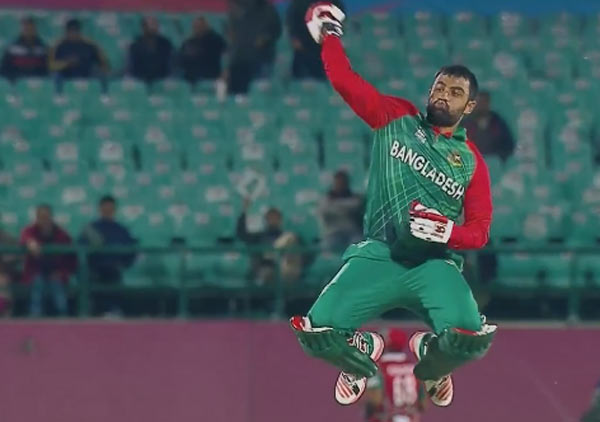
Dharmasala, India (BBN)-In 16 years as a full member of the ICC, Bangladesh have exasperated their fans far too often.
But when Tamim Iqbal creamed a drive through the covers to reach a century on Sunday night, it was the mark of a team that have gained a swagger, reports the Cricket.com.au.
Yes, Bangladesh were playing Oman, but they embraced expectations in a manner they have seldom done in the past.
Cricket historians might soon look at 2015 as the year a new superpower was born.
Bangladesh have always had the population - 156 million – and level of cricket interest to become an elite nation.
In Soccernomics, a 2009 analysis of the world of soccer, Simon Kuper and Stefan Szymanski showed that success is broadly determined by population size, GDP and experience playing the game.
If the same is true of cricket, then Bangladesh should consistently be performing as well as Pakistan, who have only a slightly larger population and no greater a history of the game: Tests were played in Dhaka before Bangladesh became an independent nation.
Recently Bangladesh have not merely been matching Pakistan but usurping them.
Last year Bangladesh beat England to qualify for the World Cup quarter-finals, and then bested India, South Africa and Pakistan - the latter a 3-0 whitewash - to advance to seventh in the ODI rankings and secure qualification for the 2017 Champions Trophy.
Transferring this form to T20 cricket has been a struggle.
In the last World T20, held in Bangladesh in 2014, the hosts were defeated by Hong Kong in the preliminary round and then lost all four of their matches in the Super 10 phase.
At the start of the year Bangladesh squared a T20I series with Zimbabwe 2-2.
But in recent weeks Bangladesh give the impression of having cracked the T20 code.
In the Asia Cup, held at home, Bangladesh bested Pakistan, Sri Lanka and the UAE to make the final.
In a sense this was unfortunate; it made Bangladesh more vulnerable in their opening WT20 game, against Netherlands, because they only had 36 hours in Dharamshala to prepare. Coping with the altitude, a wicket with pace and bounce and the Netherlands’ fast bowlers almost proved too much, but Bangladesh eeked out an eight-run win, a victory for the variety of their bowling attack and their growing nous under pressure.
It was also a victory for Tamim.
Few players have better embodied the promise, potential and underperformance of the Bangladesh side.
Rare is the opening batsman with the adroitness of his hands, or his alacrity in judging the length of a delivery.
At the age of 21, Tamim showcased these qualities with a magnificent pair of centuries in a Test series in England in 2010.
For too long after, Tamim only offered fleeting glimpses of his talents.
Another five years passed before he scored another Test hundred against a side other than Zimbabwe.
Just as for his country, 2015 was a year of deliverance for Tamim.
Against Scotland, in the World Cup, a clinical 95 guided his team to a target of 319, a game of the ilk that Bangladesh once excelled in stuffing up.
Soon after consecutive ODI hundreds against Pakistan followed, and a gargantuan 206 in a Test match too.
T20 is a format that seems ideally suited to Tamim’s strengths. Instead it has long flummoxed him: he has attempted to go too hard, too early rather than play himself in for a few deliveries before embarking on his assault. Not in this tournament.
Against both the Netherlands and Oman, Tamim begun his innings at a relatively genteel speed, at least by T20 standards, and then unveiled his repertoire of shots.
The effect has been devastating; across three matches, including the eight overs Bangladesh mustered against Ireland, Tamim has mustered 233 runs for once out.
No side will relish facing Bangladesh in the Super 10s. Although they find themselves facing Australia, India, New Zealand and Pakistan in a particularly tasking group, the days of Bangladesh being phased in tournaments such as this have passed.
Led by Tamim, theirs is a batting line-up batting with effervescent strokeplay and dexterity against spin.
The attack marries Shakib Al Hasan’s canny spin bowling with genuine pace from Taskin Ahmed and Mahrafe Mortaza. Fielding, once a weakness, is now dynamic.
Most importantly, self-belief brims through every pore of Bangladesh’s side.
There remains the tendency to underrate Bangladesh, to think of themselves as a side not battle-hardened or consistent enough to thrive on the world stage.
The notion is badly out-dated; Bangladesh are a cricketing side who are confident, savvy and thriving, and ideally balanced for Indian conditions.
For all the vagaries of T20, the next few weeks hold out the real chance of Bangladesh reaching the last four of a world event for the first time.
BBN/SK/AD